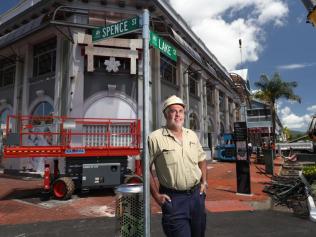Cairns man Michael Yates receives first myoelectric pattern recognition arm in Queensland
After a tragic incident left a five-year-old boy without a hand, 55 years later he has become the first person in Queensland to get a new myoelectric pattern recognition prosthetic right arm. SEE THE PROCESS
IT was a moment a lifetime in the making.
In a nondescript clinician’s room in suburban Cairns on Thursday afternoon, 60-year-old Michael Yates began to move his “fingers” for the first time in more than five decades.
After losing his arm in a traumatic explosion while playing with a detonators in the kitchen of his family home at the age of five, Mr Yates is now the proud recipient of the first myoelectric pattern recognition prosthetic arm to be fitted in Queensland.
In layman’s terms that means the Cairns Post employee can now control his prosthetic hand by activating the muscles in his elbow, with artificial intelligence that recognises patterns.

“It’s almost like playing with a new toy,” he said.
“Last night as I lay in bed trying to go to sleep, all I kept thinking about was the movements to move the fingers.”
To say he is excited about the future is an understatement.
“I’ve never actually thought about getting a hand like this, I spent the last 55 years without one,” he said.
The prosthesis is part of a new trial with Cairns business SSS Prosthetics and Orthotics.
The hi-tech body part replaces the hook that Mr Yates was using for a hand for the last 30 years.

The process for making the new arm takes between 25 to 40 hours over three weeks. While there are three fitting sessions over three hours in total.
But in the trials Mr Yates said it already felt like an exciting experience.
“It feels like a lot of fun, I’m going to enjoy getting used to it,” he said.
“I was testing it before, it’s interesting that I can have wrist rotation.”
“It’s going to be a learning process for the next few months. As for the fact I’ve never had a right hand to worry about.”
Cairns Hospital emergency department wait times explode
But after so long without an arm, Mr Yates isn’t sure what his capabilities will be yet.
“What I can do in the long run will be interesting. I don’t know what I will be able to do yet but we will see what happens,” he said.
Despite it being a trial Mr Yates said when he was given the opportunity, he knew straight away he had to accept it.

“I wanted to test this because it could give the opportunity out there to people in my situation, the younger ones, a chance at a better lifestyle,” he said.
“I lost mine in a period where there wasn’t much support with government support like the (National Disability Insurance Scheme) which is fantastic now.”
Mr Yates initially went to get fitted for another device but was told he would be a perfect fit for the myoelectric one which is fully covered by NDIS.
The Gut Health Doctor Megan Rossi talks about cost of living and book Eat More, Live Well
SSS Prosthetics and Orthotics prosthetist and owner Daniel Baldwin said because of Covid it took a while for his company to be certified to fit the carbon fibre and titanium prosthesis.
“This is the first time since it’s been released that the certification has allowed it to happen,” Mr Baldwin said.

“The myoelectric prosthetic device normally use two electrodes for simple open and close movements.
“The pattern recognition is the next step in artificial intelligence in using multiple signals to generate different grip patterns and movements within the hand and wrist.”
While fitting and testing is a lengthy process, Mr Baldwin said artificial intelligence was where things were moving to.
“The older myoelectric system required Michael to use lots of training to teach himself how to use his hand where the new pattern recognition constantly recognises different signals so it trains it to the user,” he said.
“The benefit with Michael is that despite it being 55 years he has excellent signals.
“Over time, the longer away from the amputation, the muscle signals lose their intensity. It makes it harder.”
But Mr Baldwin said in theory Mr Yates shouldn’t have good signals, but his previous use of a mechanical arm helped prepare him for his new prosthesis.

Upper limb prosthetics had always been challenging, Mr Baldwin said, because there was a lower percentage of upper limb amputees compared to lower limb.
But he expects within a weeks time Mr Yates will be able to use his prosthesis as a proper hand with a bit of practice.
“You can see how much he’s learning, already,” he said.
Technology has improved over time but with this new one Mr Baldwin wanted to make one thing clear.
“You do a see a lot on social media with 3D printing and different upper limb devices,” he said.
“This system highlights that to get it to a functional device it is actually quite complex than to get it out of a 3D printer.”
More Coverage
Originally published as Cairns man Michael Yates receives first myoelectric pattern recognition arm in Queensland





